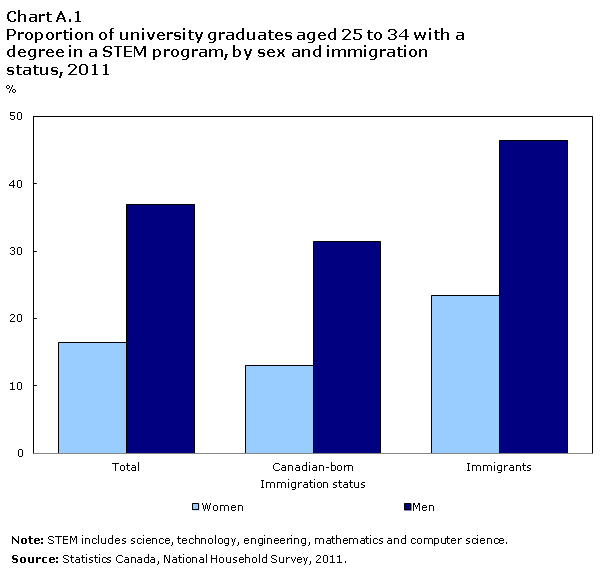Proportion of immigrants who are STEM graduates
Archived Content
Information identified as archived is provided for reference, research or recordkeeping purposes. It is not subject to the Government of Canada Web Standards and has not been altered or updated since it was archived. Please "contact us" to request a format other than those available.
Because they operate in a global labour market, the profile of STEM graduates is affected by a substantial degree of labour market inflows and outflows.Note1 One indicator of such international interactions is the proportion of immigrants who have a STEM degree.
In Canada, immigrants represent a significant portion of the population with a STEM degree. In 2011, 46% of university-educated immigrant men aged 25 to 34 had STEM degree, compared with 32% of their Canadian-born counterparts (Chart A.1). Among female university graduates aged 25 to 34, immigrants were twice as likely to have a STEM degree as the Canadian-born (23% versus 13%).

As a result, among those aged 25 to 34 with a STEM university degree, 35% of men and 38% of women were immigrants. Moreover, among men aged 25 to 34 with a STEM university degree, 9% were non-permanent residents (7% among women).
Differences between immigrants and the Canadian-born also existed within STEM programs. For instance, among women with a STEM university degree, 17% of the Canadian-born received it from an engineering program, compared with 28% of immigrants. Also, only 10% of Canadian-born women obtained their STEM degree in mathematics and computer science, compared with 26% of female immigrants.
Finally, of immigrants aged 25 to 34 with a STEM university degree, slightly less than half obtained it outside Canada.
Note
- Date modified:
